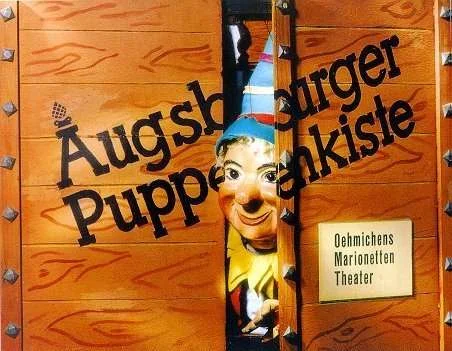The German Bagpuss- Augsburger Puppenkiste
For a certain generation born in the UK, the name Oliver Postgate reverberates around their childhood. Postgate, along with his partner Peter Firmin and his production company Smallfilms, created some of the most famous children's television characters from a small shed in Kent. Beginning their work together in 1957 with 26 episodes of Alexander the Mouse, Postgate and Firmin would go on to create Iver the Engine, Noggin the Nog, The Clangers and most famously of all, Bagpuss. The animated characters and stories that emanated from their shed radiated warmth and although sedate by the standards of today's programming are still regarded with great fondness by many people.
Although I cannot vouch for the popularity of Smallfilms creations here in Germany, there is a similar feeling among Germans for the Augsburger Puppenkiste. Founded in 1943 by Walter Oehmichen with his wife Rose Oehmichen and their daughters Hannelore and Ulla, the initial puppet theatre was simply a small stage that could be easily set up in a door frame, which they named the Puppenschrein or puppet shrine. The idea had come to Oehmichen during his time in the Wehrmacht. Based in France, he had spent his time there entertaining his comrades during lulls in the fighting, storing his puppets in a small travelling box.
The early puppet theatre was a casualty of a bombing raid on Augsburg in 1944. Although Oehmichen lost his small stage, he did manage to preserve his puppets, so that with the wars end he was able to reopen the theatre, which was now based in the Heilig-Geist Hospital. The puppets and Oehmichen initially shared the space with the Office of Statistics. In 1948, the Puppenkiste had their first performance, using local young actors to voice the puppets, the troupe performed ‘Puss in Boots’.
Among these young actors was Manfred Jenning, who would go on to become a staff writer for the Puppenkiste and would be the creative mind behind the annual year end cabaret. Beginning in 1951, the cabaret performance, orientated to a more grown up audience, is still performing today. This has become one of the trademarks of the Puppenkiste, with performances of fairy tales and popular stories for children, in addition to performances of operas and comedic cabaret shows for adults.
Another important creation during these early years was the Puppenkiste trademark opening sequence. Beginning on stage and later opening their films, the Puppenkiste or puppet box became the symbol of the troupe of puppeteers. Each performance begins with the opening of the puppet box to reveal the stage behind, modelled on Oehmichen own puppet box. The opening of the puppet box is held in the same regard here in Germany as the opening moments of Bagpuss in the UK.
Although it was famous for it’s live performances, the Puppenkiste became famous nationwide when they began to be shown on Hessische Rundfunk, only weeks after beginning of daily television broadcasts in Germany following the end of the war. These live performances would grow into fully fledged motion pictures during the 1960s, which would feature productions of classic stories, as well as original works. Among the characters featured in the Puppenkiste repertoire were the Moomin family, which would go on to be a cult cartoon for many people in the UK.
Through the 1980s and 1990s the Puppenkiste expanded to cover educational projects, with scientific topics coming to the fore. Even as new projects were created, the Puppenkiste maintained a tradition for hiring up and coming writers and actors, as they had Oehmichen had done during the 1950s. Despite severing ties with Hessische Rundfunk in 1994, the theatre would continue to be popular with regular television and motion picture projects.
Despite it’s age, the Puppenkiste would see some of it’s best years following the turn of the millenium. 2001 was marked by the opening of a museum dedicated to some of the theatres best loved characters, something the Oehmichen family had long hoped for. Interestingly, the Puppenkiste is still in the hands of the Oehmichen family, with the current incumbent, Klaus Marschall having taken over the family business in 2003.
In the same year as Marschall took over the theatre, the Puppenkiste embarked on a two year tour of Germany, with special attention paid to paediatric units in the hopes of encouraging sick children. In 2006, the theatre travelled to Augsburg’s sister city of Amagasaki in Japan. Such was the demand for tickets, the theatre ended up playing as many as three performances per day for a tour of only eight days.
There are a number of impressive aspects to the Puppenkiste, it’s longevity and popularity rival anything that can be found around the world. The appeal to children and adults is also admirable and there are few theatres that can boast such a wide age range within it’s audiences. I think though, that for myself, it is the fact that the Puppenkiste seems to be able to cover so many different topics within a vast array of different mediums. It is at once similar to the works of Small Films and Oliver Postgate, while at the same time being capable of expanding into areas that have more commonly been occupied by Jim Henson’s creations, namely Sesame Street (SesamStraße). It is an impressive feat, one that I hope will continue.








